These questions come from the old General Cicada Questions message board. The questions and answers are in reverse order. URLs found in comments are old and likely do not work.
You can tell by looking at their abdomens. The females abdomen ends with a sharp point, like a sharpened pencil. The male is more stubby, like the top of a house.
Comment by Dan Mozgai — November 14, 2005 [AT] 6:08 am
How do you tell if cicada’s are male or female?
Comment by annika — November 13, 2005 [AT] 10:22 pm
To Julianna,
Messages 48-50. Cicadas suck sap from trees and grasses during development underground and after emergence. They, in turn are “eaten” by higher predators , especially spiders, tree crickets and birds, as well as preyed upon by wasps (“cicada-killer” wasp)and cicada collecting humans, dogs and cats. The shell “exuviae” simply degenerates and gets recycled after emergence, becomes a spider’s temporary home, or gets collected and ground up for some traditional (especially Chinese) medicines.
Underground, cicada nymphs can be attacked by “entomophagic” (insect eating) fungus that kills the cicadas at some stage, but life above ground is pretty short and infection-free. Prolonged rain may promote bacterial disease.
Comment by david — October 9, 2005 [AT] 5:28 pm
Is it true that cicadas have a deathly disease?
Comment by Julianna Wojtowicz — October 7, 2005 [AT] 7:09 pm
What happens to a cicada shell when it’s left there?
Comment by Julianna Wojtowicz — October 7, 2005 [AT] 7:08 pm
what do cicadas eat and what eats them?
Comment by Julianna Wojtowicz — October 7, 2005 [AT] 7:04 pm
What do they eat and what eats them?
Comment by Julianna Wojtowicz — October 7, 2005 [AT] 7:02 pm
Hello I found a Cicada in a spider web (No spider in web) and rescued it.But it can’t fly it’s wings are messed up what do I do?
[Moderator: try to pick the web off its wing and then leave it in a bush. Maybe it will recover.]
Comment by Jennifer — September 17, 2005 [AT] 3:39 pm
do they have to sleep ? can they hurt u
[moderator: Sort of and no.]
Comment by caitlin — September 6, 2005 [AT] 4:57 pm
I live in Northern Virginia, and I’ve seen a few dead cicadas on the ground these past few weeks. They are black like the 17-year cicadas that we had last year, but they have white/greenish eyes. I’ve been hearing them singing in the trees all summer, but I thought they were the regular cicadas that we have every summer. Those are green though, aren’t they? These ones are black, and they look almost the same as the ones we had last year, only they don’t have red eyes. Are they regular annual cicadas or some special brood? Could they be Brood X and have emerged this year instead of last year? But why don’t they have red eyes, then?
Comment by Ashley — September 2, 2005 [AT] 5:20 pm
Hello,I am collecting cicada bodies and would gladly pay for shipping them if you have any. The area I am living in (Haverford, PA) does not have many this year. Please write and let me know. Thank you.
Anne
[Moderator: those are Tibicen, which are an annual species of cicada. Thanks too the massive emergence of Magicicadas, people have become “cicada aware”, and a now, finally noticing the annual species.]
Comment by Anne M — September 1, 2005 [AT] 12:52 pm
Fred,
For a great photo of Tibicen dorsata (Grand western cicada) and some locations, get Boris Kondratieff’s book “Cicadas of Colorado” CSU Press- it’s great.
Comment by david — August 29, 2005 [AT] 10:24 pm
OK, cicada professionals:
What is the ‘Grand Western Cicada? Looking through various websites, I have seen three different ‘grand western cicadas’ One series of photos clearly shows tibicen auletes, definately NOT the GW. Next series of photos from mid, upper western states, like Illinois, Iowa, etc, show a brightly yellow-marked black tibicen-type cicada. And another set, including the one on this site, shows a very un-tibicen like cicada, with a huge, oversized thorax, and a funny, undersized, narrow head. So just who/what/where is the “GRAND WESTERN CICADA, TIBICEN DORSATA?”
Fred
[Moderator: It’s this: Tibicen dorsata.]
Comment by Fred Berry — August 23, 2005 [AT] 6:01 pm
I have so many cicada in my trees that the trees are now getting rot and are dying. is there anyway i can save my 8 trees with out killing all the cicada? They are a childhood favorite and I wouldnt want to kill them but i just bought my home and the 8 trees have been there forever and id like to keep them too. please help! 2 trees are dead and need to be removed before they fall….please dont let more dye too.
Comment by April Nowell — August 23, 2005 [AT] 8:35 am
Wile on our deck today (August 21, 2005) I spotted and took a picture of this insect that I THINK might be a Tibicen Cicada? I don’t know, I have never seen a Cicada before. Of the pictures I found online, that seemed to be the closest match. Could someone confirm if it is a Cicada, and if so what kind it is? After reading the message here I went back out to take a photo with a newspaper, but it was gone. I have posted 4 pictures on my web site at
http://www.softechvt.com/cicada/cicada.htm.
Thanks!
Steve
[Moderator: it’s definitely a Tibicen, and probably a Tibicen pruinosa.]
Comment by Steve Smith — August 21, 2005 [AT] 11:25 am
Can anyone explain to me why I have been seeing cicada on my trees? I live in SC and this is the first time in the 20 years I have lived here that I have noticed these nasty insects. We used to have them in Northern VA about every 7 years but I though by moving down here they wouldn’t be here. I heard a bunch of them in the pine trees last night when I was in my backyard.
Comment by kim — August 16, 2005 [AT] 1:39 pm
My son found a cicada in the driveway today. It has been extremely hot outside so we brought it inside and made a little habitat for it which includes a pine branch, pine straw, dirt, and water on one end. It immediately grabbed ahold of the pine branch where it remains motionless. I prepared him it will likely have a very limited life span. No loud noises yet. Looks like he may mault and I know the kids will enjoy watching.
PS. I operate a municipal ULV insecticide fogging truck and I felt a little guilty leaving it outside. Plus as slow moving as this guy is, he would no doubt ended up as somebodys lunch.
[Moderator: Well, it could be a female — the females don’t make noise.]
Comment by Russ — August 15, 2005 [AT] 6:18 pm
Hi my son and I are trying to find out some info on cicada’s in our area. We live in Freehold, NJ and have been hearing them at night for weeks now. Tonight there is one perched on our screen door. From the websites I’ve read it says that there would’nt be any emerging in ’05, and that they only live for 2 weeks. They’ve definitly been out there more than 2 weeks.Or am I not getting the right info??
Thanks
Donna
[Moderator: in Jersey you have two basic types of cicadas: 1) the annual type, and 2) the periodical type which arrive every 17 years. Right now you’re seeing the annual type, which belong to the Genus Tibicen]
Comment by Donna D. — August 14, 2005 [AT] 10:39 pm
The Cicadas are here in the Upstate of South Carolina. I live in a little town southwest of Greenville SC called Honea Path. We have Oak and Chesnut Trees and the are singing wonderfully all day like I used to hear them in Southern France.
Now here I need an expert for answers? I heard the same noise last year. Not quite as prominent then this year but still I could hear them well every day.
This year I have been looking around and found some dead Magicicadas.
I am a little lost about this 17 year cicle. How could I have heard some last year and this year.
Are they other types of cicadas that live every year and make a similar noise?
Also as I go about enjoying these wonderful creatures of nature I hear being closer some high pitch singing less loud and frequent?
I would be thankful if anybody can give me more information. Suggestions of site with information and an excellent book about cicadas.
I feel in heaven, romantic and this wonderful noise while reading a book under a tree is an awesome feeling.
Edmond Schafeitel
Honea Path SC
Message by Edmond Schafeitel — August 14, 2005 [AT] 8:38 am
Comment by Edmond Schafeitel — August 14, 2005 [AT] 8:53 am
Yesterday I was at a picnic with my family and spotted what seemed to be a large dragonfly buried in the grass dead. So I kind of kicked at it and it started buzzing. Come to find out it was two cicadas apparently mating. Since my daughter was with me and she likes to collect bugs of all sorts, we put it in a container with leaves and twigs and a catipillar that she had found earlier. How rare is it to find them in the grass like that? Port Huron, MI
Comment by Todd Taylor — August 14, 2005 [AT] 7:53 am
[Moderator: that’s a Tibicen, not a Magicicada, but go on…]
For the last few nights I have had the opportunity to observe the behavior of the Magicicada in my back yard. I live in Marlboro, NJ and this year the air is filled with the sound of the percing buzzing calls of the male cicada and the approving clicks of the females.
I have been painting an official size NBA basketball half court on my driveway. My family is anxious for me to finish so I have been painting into the night with two flood lights. The first night I stayed out late painting (till 2:30 AM) I immediately became aware that this was not going to be a normal night in Marlboro. As night fell, the intensity of the buzzing calls increased and the cicada began gathering in the tree above me (a towering 150 year old red maple tree). As I painted, I noticed that fresh leaves from the tree where slowly raining down around me often accompanied by what appeared to be shoots of dead grass, with their tiny dry rootlets attached. The grass appeared to have been coated with a sticky substance and teased so that the roots and leaves looked like they had been curled.
The leaves also appeared to have been altered. Sections of the leaf to the right and left of the mid-line had been removed in a roughly symetrical pattern, often punctuated by holes on either side. The substance coating the leaves had an acrid musky unpleasant smell (at least to me). It also seamed to be tuning the fresh green leaves a yellow to orange to brown color.
As I continued to paint, the cicadas in the tree above me seemed to be agrivated by my presence. They continued to gather above and the raining down of leaves increased, some landing on me directly. When ever I repositioned the flood lights their calls rose in intensity.
Finally, a particularly large cicada flew down out of the tree and aimed itself directly at my head causing me to duck to avoid a collision. I quickly set the light down and darted away from the spot light, and into the dark shadows of my yard, to avoid a second aireal assault by the cicada. The giant insect touched down directly in the spotlight created by the lamp and took up position as close to the light as possible, It was then that I noticed the bright red glowing eyes of this cicada as it peered into the light and beyond it into the night. I quickly learned the rules of this relationship. Don’t touch the light and don’t block the light. If you do, the arial assaults resume. I finally reached an uneasy peace with the cicada. I could slowly move the light, without prompting aggressive behavior from the cicada, if I made sure to keep the insect in the most prominent position under the spotlight.
All kidding aside, the events I recorded here did happen to me in the middle of the night when I entered the cicada’s space under that old tree. On the succeding three nights it took me to finish the basketball court I encountered the same behavior. I feel I have a deeper understanding of these cicada behaviors now although it contradicts the official excepted version of their behavior.
Has anyone out there had a similar experience with cicadas in their area or witnessed any other unusual behaviors by cicadas? If so I’d love to read about them.
Comment by Daniel Ross — August 13, 2005 [AT] 11:35 pm
Here in Albion my brother and I found a cicada under our outdore table umbrella we don’t know why it was there.We had it in a container but we let it go at night when we were done looking at it it was kewl but we were scared to hold it so we looked up on this website if they bite. And it told us they dont but we did’nt want to take a chance of it laying eggs in us so we decided to show our mom and when we did she freaked out so then we showed our step father and he yelled at us for having it so then like I said we let it free and it didn’t fly cuz it was too cold out and it was raining so then we decided to put it back on our umbrella so it didn’t get wet so it could fly away the next morning and we didnt take it abdomin off like dum rejected people do just for their entertainment. have a nice day c ya bye.
Comment by Heather — August 11, 2005 [AT] 5:56 pm
will there be any more big emergences of magicicada near the baltimore area anytime soon? I’m not expecting any news making hatchings near my home but i would like to drive to a close by place with a fairly large brood brood x was huge in martinsberg wv last year for example.
Comment by Vince Matson — August 10, 2005 [AT] 8:58 pm
hi, i am just curious if what i’ve been seeing on my tree in my yard are cicadas!!! I have found several body casingswhich are brown in color and from the middle of the back of the head to the middle of their back or open with embelicalcords or some kind of feeding line inside I saved four that I found because I found them very interesting and was determined to find out what they were! Well, I will tell you!!!!!!!!!!! I went outside to let my dogs out around eleven thirty pm one evening last week and saw the same brown insect attacted to the tree with it’s front claws several hours later this amazing huge insect was on top of it!! It was about 4 inches long from head to end of body ( body was a tanish color) but the wings on this creature were amazing!! they were theabout 2 to 3 inches long and irridesant green, blue, pink pearly looking. The head was tan/light green in color with black eyes. Was i scared you ask you bettcha!!! because the are so huge!!!!!!!! But i was also intreged an so astonished that this big creature came out of that excoskeleton(is that what they are called I am new to this) i deal with dogs all day i am a dog groomer!!!! So anyway last night at eleven thirty pm I found another one on my tree so i made my boyfriend come out to confirm my findings!!!! Because i really don’t think he beleived me on how big they are! Boy was he amazed and it made him a little nervous we both walked right up to the tree it seemed to be looking right at us it was upon the casing it must have just shed its skin!! Because at first it looks as if they are feeding on another insect until they walk off the body casing and you can see the inside with the embilical cords inside. I came to the conclusion that after they leave their skin they dry their wings rest for a few minutes about 20 minutes or so and they fly away leaving the casing behind!! I have one that i found on the ground it wasn’t injured and so i put in an aquarium and i am patently waiting for it to shed its skin ! once it comes out i will set iot free I believe in that !!! If any one has any information on this creature please let me now………………sincerely, amy the bug lady!!!!
Comment by amy gentile — August 8, 2005 [AT] 4:23 pm
CICADAS ATTACKING GRAPES IN ASIA (Afghanistan, Iran, Iraq, and Syria)
We are working on a project to assist grape growers in Asia to better manage cicadas that have been found on grape roots. Goals are to: (1) Determine the species of cicada, (2) create bio-control tactics to limit the damage done by the nymphs to grapevines.We would be interested in cicada projects which are being conducted to manage cicadas by any means (bio-control, cultural, and even chemical). Please respond to email Millern [AT] wooster.edu
Thank you
Comment by Nathaniel Miller — August 7, 2005 [AT] 6:56 pm
In Seattle, Aug 6, 2:30 pm, 80+ degreees (Thats quite hot for up here). I cam out of mygarage following a sound that reminded me of an air hose leak or a water hose still left on. I followed it past the house, and cupping my ears, followed the sound to a spot on a doug fir about 100′ high in my front yard. It was coming from what looks to be a squirrel’s nest aobut 30′ up. I had to ask my wife what it was, i have not ever heard these things before. It ended up being a sort of high pitched buzzing noise.
Comment by lloyd — August 7, 2005 [AT] 8:31 am
Well, they are driving me crazy here in eastern Iowa. Very Very loud in our partially wooded backyard. I know they have not been this loud for several years. When I was pumping gas nearby our home there was a cicada (the largest I have ever seen) climbing up the gas pump. It really startled me ( I swear it was staring at me! ) Ha! Anyway, is it possible this is the 17th year here in Cedar Rapids , Iowa? They have been everywhere and the sound at night is almost deafening.
Comment by sara — August 5, 2005 [AT] 10:05 pm
How come t.chloromera sometimes has a black thorax and neon green wings and sometimes doesn’t? My theory is that when they were in molt they were exposed to too much light, or there evolving iton another species.
Also whats the difference in color between t.lyricen and t.robinsonianus? And also when your identifing a cicada does the same species all look pretty much exactlly alike or does it very alot? And if you found one t.pruinosa in north carolina and another in florda would there proportion change any or just the color?
Comment by justin — August 3, 2005 [AT] 4:08 pm
Dear sirs,
In the last few days, that awful sound of the cicada has returned, unexpected in this portion of SE Ohio (Athens). This last weekend, we happened to drive to Canaan Valley, WV (near Davis) and stayed two days… NO NOISE! I assume from this that the current brood hatch is in SE Ohio, but not expansive to the east. Two questions: #1: I can’t find any map or prediction for a brood hatch (of the 17 year nor 13 year cycles) that match this year (looked on the UofMich website). What is the distribution for this year supposed to be? Could this be the 2004 brood running late? #2: Could a cicada “hitch a ride” on our car, transported to a new, virgin teritory like Canaan valley, and start a new infestation in 18 years? Alright, what if a PAIR of them hitched a ride under the hood of my car and dropped off there? I shudder to think what I have done to that paradise if this is true.
Thanks for any help you can supply me… I will share this with our TV viewers. -Kirk G, WTAP TV Weatherman
Comment by Kirk Greenfield — August 1, 2005 [AT] 7:47 am
When I went out for a smoke at about 3am in southern Ontario area, I saw a Cicada on the road, I caught it and I have it in a jar in my room. I thought my cat might get some fun out of viewing it from outside the jar… but as soon as my cat got in my room it went into killing mode. I couldnt go near my cat it was so agitated. Do Cicadas give off a scent that would scare off or perhaps entice predators?
(P.S, the next morning I let the Cicada go about its business back outside, unharmed by my cat)
Comment by Evan — July 29, 2005 [AT] 3:22 am
There is a cicada parked on the outside of my window right now. I live in South Nyack, NY. I happen to have a very deep phobia of bugs, especially flying ones, and the thought of having to deal with a cicada hatching… I didn’t think they came to Nyack!!!
Can someone please verify for me whether or not a brood is hatching right now? In Rockland county New York? I am shaking as I write this. Please let me know if I have to spend the summer elsewhere!!
I know they are hamless. Phobias are irrational. I just am terrified of them. I hope this is a fluke….
Comment by MzOuiser — July 26, 2005 [AT] 12:10 pm
These bugs are scary and it seems that I have a million of them in my yard, can someone tell me when are they going to go away.
Comment by Angelika — July 25, 2005 [AT] 11:14 pm
I have a green and black Cicada and I live in Minneapolis, Minnesota. Are they usually something that lives this far north?
Comment by Johnny — July 25, 2005 [AT] 8:47 am
Okay, I’m sorry if this is a Cicada loving site, but these things are DRIVING ME CRAZY! I live in Atlanta, GA — 2005. Please, please, please someone tell me that I will not have to deal with this here for another 17 years?
Comment by Heather — July 25, 2005 [AT] 7:13 am
hi ronald. i’m shay from south carolina. i “googled” cicadas florida. you should visit http://www.floridanature.org. yes, cicadas do thrive in florida. happy searching!!
Comment by Shay C — July 22, 2005 [AT] 8:45 am
I live and work here in NE Philadelphia. I am from Seattle and this is the first time I have seen this bug. We found one outside our office here at Naval Station NAVICP Philadelphia. I thought it was a giant fly at first, figured he was trying to escape the hurricane season down there. However, I found the pictures of a cicada on your site through yahoo and it was a direct match with the green one I saw. I Just wanted to let you know they were here. John
Comment by John Reynolds — July 22, 2005 [AT] 7:04 am
I found a cicada here in tampa at alafia state park along a bike trail that a ride frequently. I would like to know if this is just an abnormal finding? I kept the insect for proof. I grew up in DC and didnt think that a cicada could or would grow here? Can anyone give me some answers or direction on the possibility or cicadas in Tampa Florida? rcarkhuff [AT] hotmail.com
thanks
Comment by ronald carkhuff — July 21, 2005 [AT] 7:01 pm
O.K. I’M COMPLETELY HOOKED ON CICADAS NOW. I’M FROM THE SOUTH (ENOREE,SC) SO MY SUMMER NIGHTS, ALL MY LIFE, HAVE BEEN FILLED WITH THE BEAUTIFUL SONG OF THESE CREATURES (IT’S ALMOST DEAFENING/BUT LOVELY). BUT SINCE MY SIGHTING LAST NIGHT (I WATCHED ONE EMERGE!) I CAN’T GET ENOUGH INFORMATION!! MY SON AND I WENT OUT THIS AFTERNOON AND SAW SCUDS OF SHELLS UNDER TWO WILD CHERRY TREES. MY QUESTION IS…HOW DO YOU KNOW WHAT KIND OF CICADAS YOU ARE HEARING, OR WHAT KIND ARE IN MY AREA? (PS — LOVED COLLIN’S BAD JOKE COMMENT — HA! HA!)
Comment by Shay C — July 21, 2005 [AT] 6:48 pm
YES…I’VE WITNESSED IT TWICE MYSELF (IN UPSTATE SC). IT’S REALLY KINDA SAD. THE WHOLE COMMOTION OF IT IS HORRIBLE. DON’T REALLY KNOW MUCH ABOUT IT THOUGH.
Comment by Shay C — July 20, 2005 [AT] 9:14 pm
have you ever heard of a cicada killer it looks like a bee part wasp insect i saw one one time carring a cicada
Comment by holly — July 15, 2005 [AT] 1:43 am
Edward,
If you really want to keep a Cicada something like a terrarium would be more suitable. Cicadas have mouth sucking parts known as a beak and they actually suck the Xylem of plants. So what would be good is to get a branch from a tree and stick it in some water then put the cicada on the branch, if you’re lucky you will see it start to feed. They like to feed for about an hour.
Also, Cicadas don’t really live long in captivity maybe about a week to 10 days.
Gerry
Comment by Gerry — July 6, 2005 [AT] 9:34 pm
I just realized that in my excitement I didn’t tell anyone where it was that I found it. I’m in Elmont, N.Y. which is just over the border from Queens, NY.
Comment by edward b ford — July 4, 2005 [AT] 6:46 pm
July 4, 2005
I just found one attached to the louverd window of my basement. It was brown and in pre-emergence mode. I told my kids what it was and that we’d check it out in the morning to see if it had come out. A half an hour later I happend to be going out to the car and took a look at it and low and behold it was half way out. I waited another half hour taking photos before deciding to capture it. I now have it in a tupperware container about 5in deep by 8in wide and 14in long. I put some large wood chips for it to crawl on and some grass and some of the hedge. I also put some “honeysuckle” in there because I’m not sure what they eat. Any how I’d like any and all advice as to what I should do from here. I know that the Chinese keep them as pets. I’m sure that my girls would love that although they are very noisey.
Comment by edward b ford — July 4, 2005 [AT] 6:44 pm
I wanted to write that on june 28, 2005 in The Pas Manitoba Canada, i was out taking a walk and found a bug of the likes I have never seen before. I went home and looked it up and it was a cicada. I was surprised as it does not seem to be native to the north. I feel quite lucky to have found one- it was so big and beautiful (in its own way)
Brandy Stener
Comment by Brandy Stener — June 28, 2005 [AT] 7:34 pm
I wanted to write that on june 28, 2005 in The Pas Manitoba Canada, i was out taking a walk and found a bug of the likes I have never seen before. I went home and looked it up and it was a cicada. I was surprised as it does not seem to be native to the north. I feel quite lucky to have found one- it was so big and beautiful (in its own way)
Brandy Stener
Comment by Brandy Stener — June 28, 2005 [AT] 7:34 pm
Hi, I just wanted to say that on June 28 while out for a walk, I found a cicada. This is the first i have ever seen in my life! I did not even know what it was until i came home home and looked it up. Beautiful and interesting… So far as I know- they are not native to these areas so I feel lucky to have seen one. Brandy S.
Comment by Brandy Stener — June 28, 2005 [AT] 7:26 pm
When do the cicadas usually come out in Michigan? It is hot and muggy here and I am waiting for them.
Comment by Britta — June 24, 2005 [AT] 6:00 am
I found a cicada here in Central Texas in the track of my sliding glass door a few days ago, and it’s the smallest one I’ve ever seen in my life. I guess it never occured to me that they might come in different sizes. It’s small and brown (might have been green when alive), and about 3/4 inch from eyes to wing tip. I have an image I scanned of it with a ruler measuring it. I was actually pretty excited about it. Its always exciting to discover creatures you’ve never seen before, and Texas is full of those kinds of things. (I’m not from Texas) I’d also like to mention it occurred to me that the cicada sounds here are much different, more pleasant, less shrill than in Mississippi or North Carolina, and I also find that interesting. My parents and grammy mentioned the cicadas have not yet come out where they live in Mississippi, which is very unusual. They haven’t heard any this summer yet.
Comment by Mara — June 20, 2005 [AT] 7:38 am
Lately there has been a noise right outside my window at night that sounds just like a cicada. I’m fairly familiar with the sound cicadas make from my travels around the world. The thing is that I live in Western Washington State on the rainy side of the mountains, and I didn’t think that cicadas could live in this area because of the climate. Am I wrong? Can cicadas live in the wet and cold Pacific NW? If not, what sounds just like a cicada and lives in the Pacific NW (that sounds just liket he start to a bad joke)?
Comment by Collin — May 22, 2005 [AT] 1:39 pm
The American writer and naturalist Henry D. Thoreau mentions in his journal “a sort of black eyed septendecim” that began its call (at Concord, Massachusetts) around the first of June in 1854. Would you care to guess what particular species he might have referred to?
Thoreau sent a specimen to Harvard librarian and entomologist Thaddeus William Harris, who responded (apparently referring by “C. 17" to a print or a description in his own book on insects) thus: “The Cicada seems to be a female, and of course when living could not make the noise peculiar to the other sex. It differs from my specimens of Cicada septemdecim (& indeed still more from all the other species in my collection). It is not so large as the C. 17; it has more orange about its thorax; the wing-veins are not so vividly stained with orange, and the dusky zigzag on the anterior or upper wings, which is very distinct in the C. 17, is hardly visible in this specimen. It has much the same form as the female C. 17; but I must see the male in order to determine positively whether it be merely a variety or a different species.”
Comment by Bradley P. Dean — May 17, 2005 [AT] 3:31 pm
You might see some stagglers in the DC area. Nothing like last years emergence, but a few here and there.
Comment by Administrator — May 11, 2005 [AT] 7:33 am
Im curious will or when there be Cicada sight seeing in wash Dc area?
Comment by Merritt — May 10, 2005 [AT] 11:27 pm
Long Island’s Brood X disappointment.
Is it possible that the small emergence last year was simply an early emergence of Brood XIV four years early? Brood XIV is the dominant brood in this area and 4 year early emergences have been noted in many areas in the past. I suspect that previous appearances of Brood X on Long Island may have actually been actually members of Brood XIV.
Comment by AJay — May 9, 2005 [AT] 12:47 pm
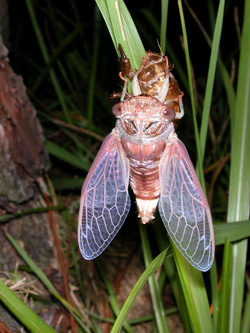

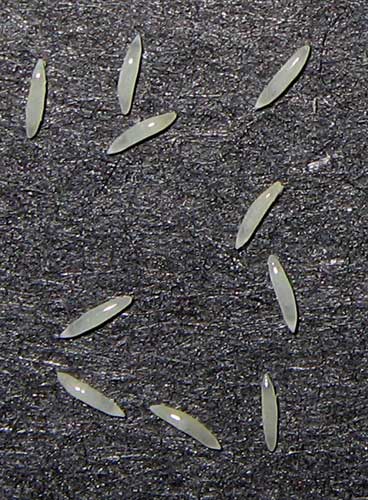
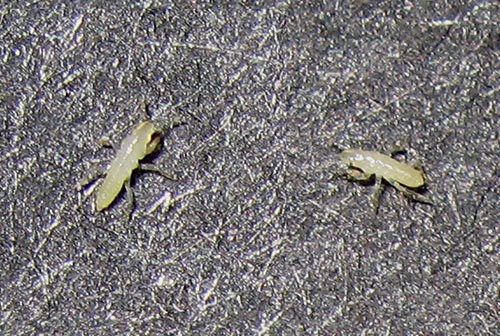
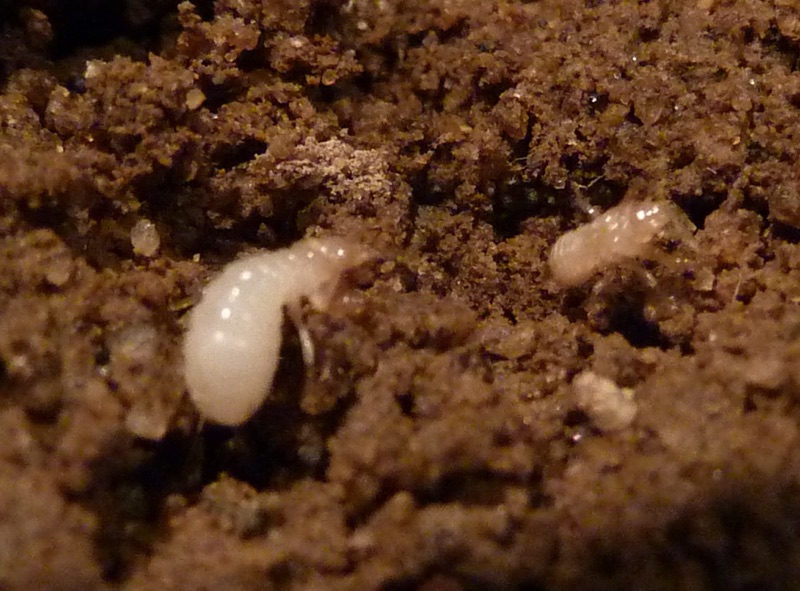
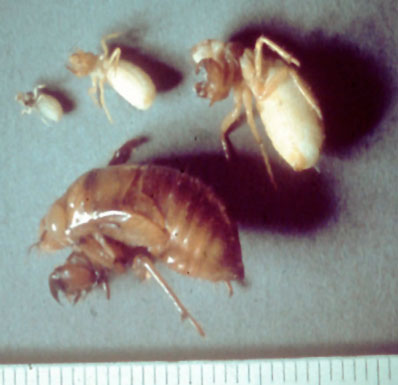
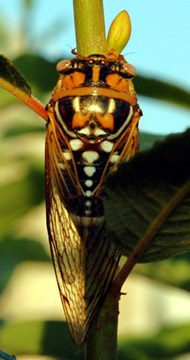 Bill from Lincoln, Nebraska sent us this awesome photo of a cicada. I’ve never seen a cicada quite like this one. It’s as pretty as a butterfly. My guess is it belongs to the genus Diceroprocta, but I don’t know what species it is. Anyone know? If so, leave your guess in the comments section below.
Bill from Lincoln, Nebraska sent us this awesome photo of a cicada. I’ve never seen a cicada quite like this one. It’s as pretty as a butterfly. My guess is it belongs to the genus Diceroprocta, but I don’t know what species it is. Anyone know? If so, leave your guess in the comments section below.